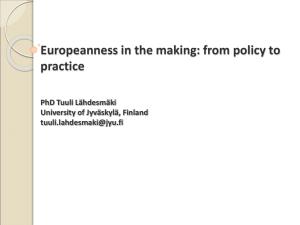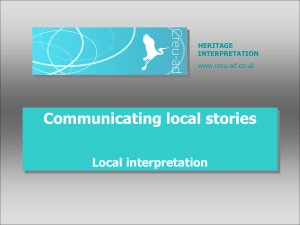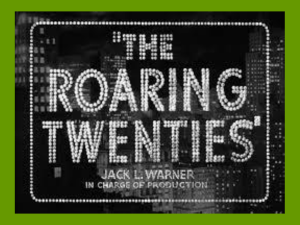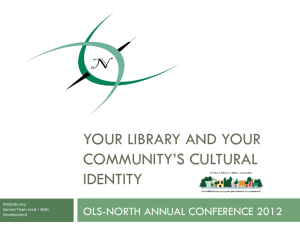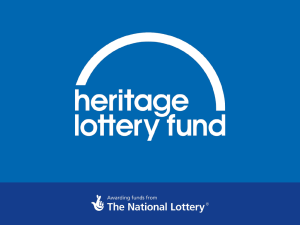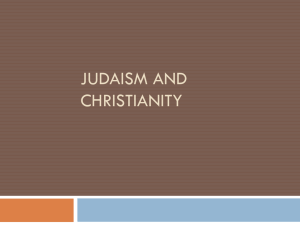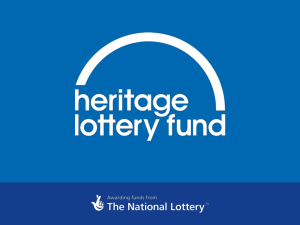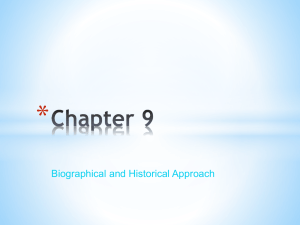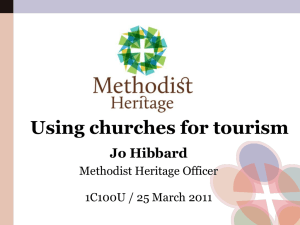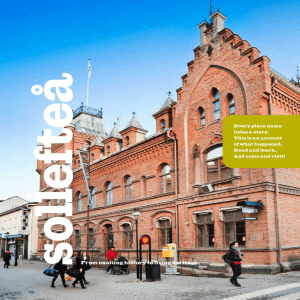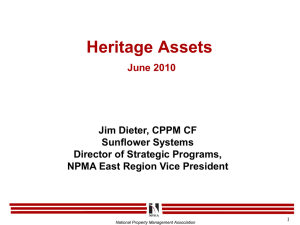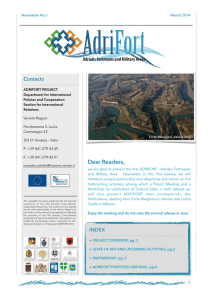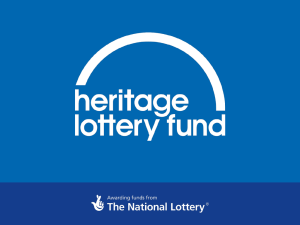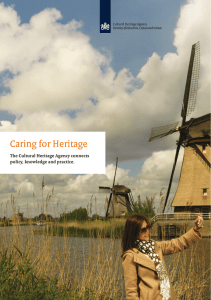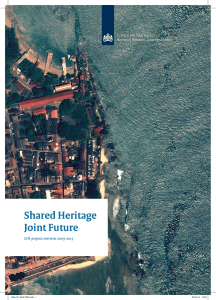Section 4 - St. Pius V School
advertisement
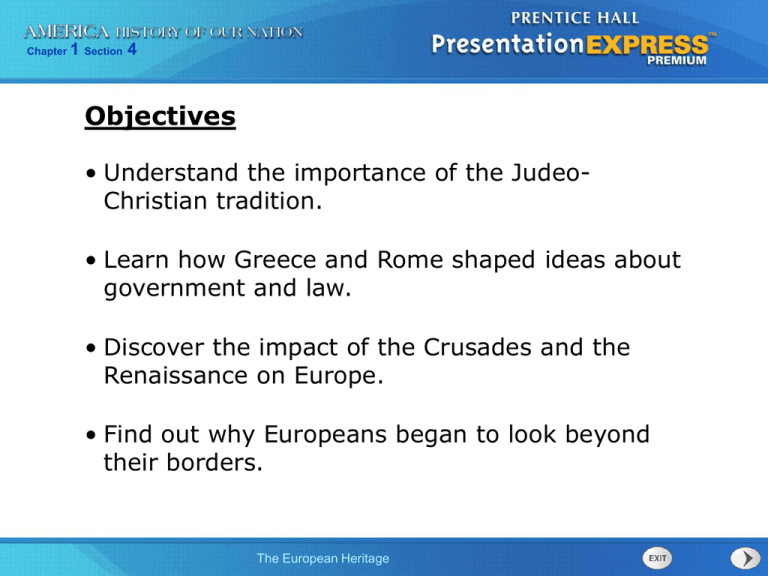
Chapter 1 Section 4 Objectives • Understand the importance of the JudeoChristian tradition. • Learn how Greece and Rome shaped ideas about government and law. • Discover the impact of the Crusades and the Renaissance on Europe. • Find out why Europeans began to look beyond their borders. The European Heritage Chapter 1 Section 4 Terms and People • monotheism – the idea that there is only one God • Jesus – a Jewish teacher who founded Christianity about 2,000 years ago • salvation – in Christianity, the means for saving one from evil; everlasting life • direct democracy – a form of government in which an assembly of ordinary citizens makes decisions • republic – a form of government in which people choose representatives to govern them The European Heritage Chapter 1 Section 4 Terms and People (continued) • feudalism – a system in which a ruler grants parts of his land to lords • Martin Luther – a German monk who sparked the Protestant Reformation in 1517 • Henry the Navigator – a Portuguese prince who, in the 1400s, set up a center for exploration to train sailors • Vasco de Gama – a Portuguese sailor who found a water route around the southern tip of Africa in 1498 The European Heritage Chapter 1 Section 4 What major influences shaped European civilization? European beliefs and values were influenced by Judaism and Christianity, collectively referred to as the JudeoChristian tradition. The political traditions of Greece and Rome also influenced Europe. The European Heritage Chapter 1 Section 4 Around 1700 B.C., a system of beliefs called Judaism arose among the Israelites, a nomadic people of the Middle East. Judaism was the first major world religion to teach monotheism. The Israelites credited Moses with bringing God’s laws to them. The European Heritage Chapter 1 Section 4 Jews believed that every Jew must obey the Ten Commandments, a set of religious and moral rules. This belief formed the basis for the later view that no person is above the law. The European Heritage I. VI. II. VII. III. VIII. IV. IX. V. X. Chapter 1 Section 4 About 2,000 years ago, a Jewish teacher named Jesus of Nazareth began preaching in the region around the Sea of Galilee. The European Heritage Many believed he was the Messiah, the Savior chosen by God. Crowds flocked to hear him teach. Chapter 1 Section 4 The Roman rulers of Jerusalem saw Jesus as a political threat, and they arrested, tried, and crucified him. Followers of Jesus said that he rose from the dead three days later. His life and teachings inspired a new religion, Christianity. The European Heritage Chapter 1 Section 4 Christianity Christian Beliefs • The religion is based on the belief that Jesus was God in human form and that he came to Earth to save the world. Teachings of Jesus • His teachings emphasized love, mercy, and forgiveness. • He taught that all people have an equal chance for salvation. Spread of Christianity • Jesus’ teachings appealed to the poor and the oppressed. • This helped the religion spread from the Middle East across Europe. The European Heritage Chapter 1 Section 4 At first, the Romans viewed Christianity as a threat, and they often killed Christians. Later, emperors accepted Christianity and made it the official religion of the Roman Empire. Eventually, it became the dominant religion in all of Europe. The European Heritage Chapter 1 Section 4 Many of Jesus’ followers, such as Paul, helped spread Christianity throughout the Roman Empire. The European Heritage Chapter 1 Section 4 Spread of Christianity to A.D. 476 The European Heritage Chapter 1 Section 4 Judaism and Christianity shaped European religious and moral thinking. At the same time, ancient Greek and Roman ideas shaped European political traditions. Greek and Roman ideas would later deeply influence the founders of the United States. The European Heritage Chapter 1 Section 4 Athenian Democracy Setting • In the fifth century B.C., the Greek city-state of Athens had a burst of learning and creativity that included the birth of democracy. Direct Democracy • Athens was a direct democracy. Limitations • Women, slaves, and foreign-born people could not participate in government. • All adult male citizens could participate in the Athenian Assembly. The European Heritage Chapter 1 Section 4 Around 900 B.C., a few small villages in central Italy began growing slowly into the city of Rome. In 509 B.C., the Romans overthrew their king and set up a republic, in which an elected senate and assembly made the laws. Principles in Rome’s code of law later became part of the American system of justice. The European Heritage Chapter 1 Section 4 Some of the ideas that the American system borrowed from Rome are: Everybody is equal under the law. People accused of crimes are considered innocent until proven guilty. The European Heritage Chapter 1 Section 4 Eventually, the Roman Republic collapsed and was replaced by the Roman Empire, which lasted about 500 years. The European Heritage Chapter 1 Section 4 In A.D. 476, the Roman Empire fell to invaders. The 1,000-year Middle Ages began as Europe fragmented into many small states and developed into feudalism. The European Heritage Chapter 1 Section 4 The Roman Catholic Church had great power in the Middle Ages and daily life revolved around it. The Catholic Church was the center of learning. Outside of members of the clergy, few people were able to read and write. The European Heritage Chapter 1 Section 4 Starting in 1096 and extending over the next 200 years, the Roman Catholic Church supported nine crusades to win back the Holy Land. The European Heritage Chapter 1 Section 4 Although the Crusades ultimately failed, they had important long-term effects: • Europeans had closer contact with the more advanced Muslim civilization. • Europeans learned about advanced technology used for navigation. The European Heritage Chapter 1 Section 4 The Renaissance Time Period The Renaissance, a rebirth of learning in Europe, began in the 1300s. Philosophy and Art European scholars and artists rediscovered classical Greek and Roman texts and art. Science and Inventions Johann Gutenberg’s printing press made more books available and boosted literacy rates. Powerful New NationStates The new nations—Spain, Portugal, France, and England—shifted important trade routes from the Mediterranean to the Atlantic Ocean. The European Heritage Chapter 1 Section 4 Since the late Roman Empire, most Europeans had been Catholic, but some were unhappy with the Church. The European Heritage In 1517, a German monk named Martin Luther demanded that the Church reform, but his demands were rejected. Chapter 1 Section 4 Luther rebelled against the Church and led the Protestant Reformation. Over time, the movement split, and many Protestant churches emerged. The Reformation also started a long series of wars between Catholic and Protestant forces in Europe. Protestants The European Heritage Catholics Chapter 1 Section 4 Beginning of the Age of Exploration Center for Exploration • In the 1400s, Prince Henry the Navigator set up a center for exploration at Sagres, Portugal. • There, sailors learned to use the magnetic compass and the astrolabe. Water Route Around Africa • By 1498, Portuguese sailor Vasco da Gama passed the southern tip of Africa on his way to India. • His course became an important trade route and helped boost Portuguese wealth and power. The European Heritage Chapter 1 Section 4 Section Review QuickTake Quiz The European Heritage Know It, Show It Quiz


